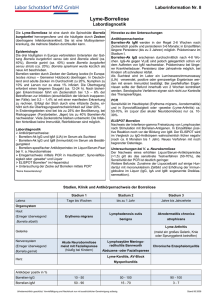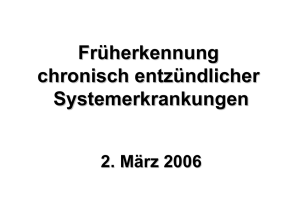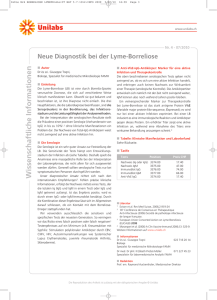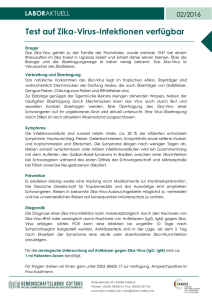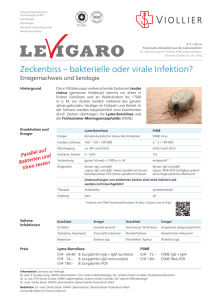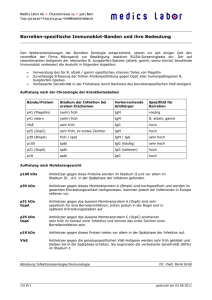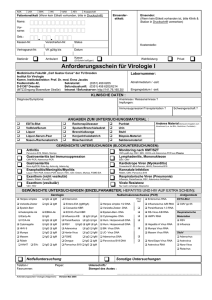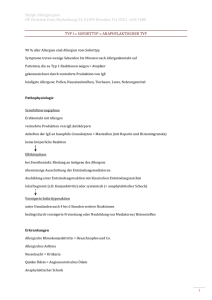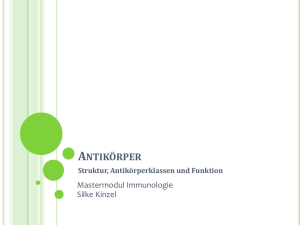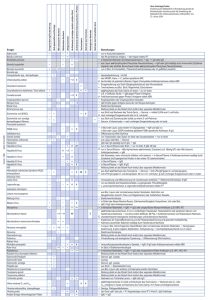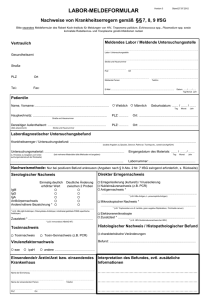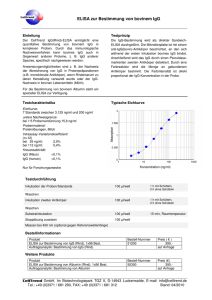Bp IgG/IgM gemeinsam - VIRO-IMMUN Labor
Werbung
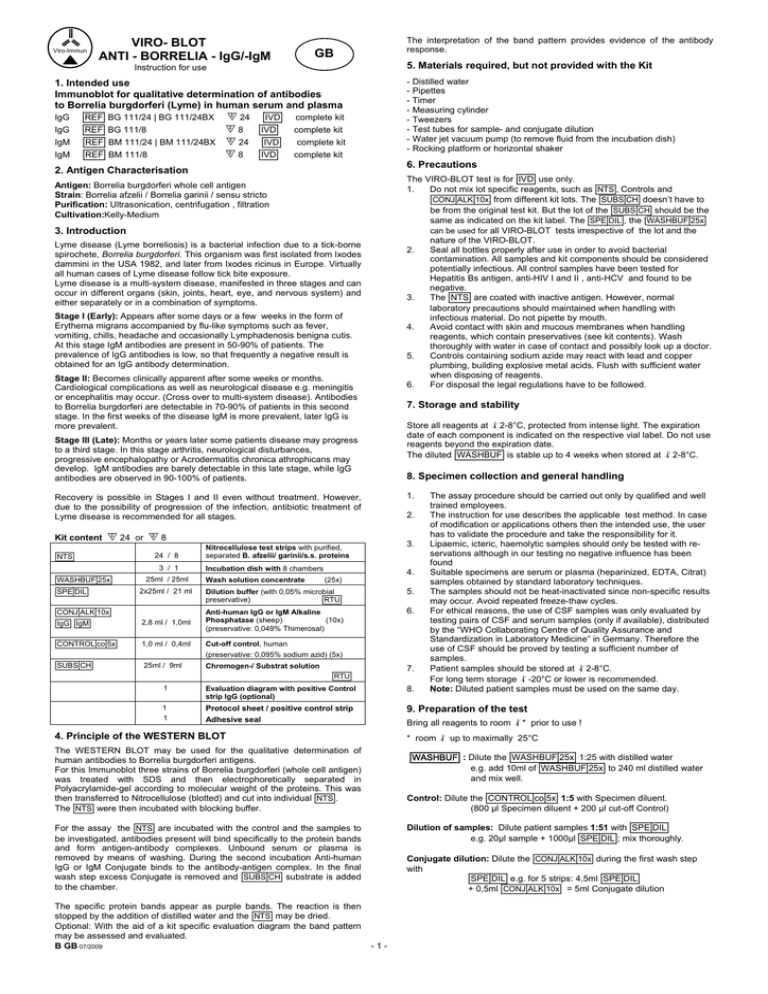
Viro-Immun VIRO- BLOT ANTI - BORRELIA - IgG/-IgM The interpretation of the band pattern provides evidence of the antibody response. GB 5. Materials required, but not provided with the Kit Instruction for use - Distilled water - Pipettes - Timer - Measuring cylinder - Tweezers - Test tubes for sample- and conjugate dilution - Water jet vacuum pump (to remove fluid from the incubation dish) - Rocking platform or horizontal shaker 1. Intended use Immunoblot for qualitative determination of antibodies to Borrelia burgdorferi (Lyme) in human serum and plasma IgG [REF] BG 111/24 | BG 111/24BX s 24 [IVD] complete kit s 8 [IVD] complete kit IgG [REF] BG 111/8 complete kit IgM [REF] BM 111/24 | BM 111/24BX s 24 [IVD] s 8 [IVD] complete kit IgM [REF] BM 111/8 6. Precautions 2. Antigen Characterisation The VIRO-BLOT test is for [IVD] use only. 1. Do not mix lot specific reagents, such as [NTS], Controls and [CONJ|ALK|10x] from different kit lots. The [SUBS|CH] doesn’t have to be from the original test kit. But the lot of the [SUBS|CH] should be the same as indicated on the kit label. The [SPE|DIL], the [WASHBUF|25x] can be used for all VIRO-BLOT tests irrespective of the lot and the nature of the VIRO-BLOT. 2. Seal all bottles properly after use in order to avoid bacterial contamination. All samples and kit components should be considered potentially infectious. All control samples have been tested for Hepatitis Bs antigen, anti-HIV I and II , anti-HCV and found to be negative. 3. The [NTS] are coated with inactive antigen. However, normal laboratory precautions should maintained when handling with infectious material. Do not pipette by mouth. 4. Avoid contact with skin and mucous membranes when handling reagents, which contain preservatives (see kit contents). Wash thoroughly with water in case of contact and possibly look up a doctor. 5. Controls containing sodium azide may react with lead and copper plumbing, building explosive metal acids. Flush with sufficient water when disposing of reagents. 6. For disposal the legal regulations have to be followed. Antigen: Borrelia burgdorferi whole cell antigen Strain: Borrelia afzelii / Borrelia garinii / sensu stricto Purification: Ultrasonication, centrifugation , filtration Cultivation:Kelly-Medium 3. Introduction Lyme disease (Lyme borreliosis) is a bacterial infection due to a tick-borne spirochete, Borrelia burgdorferi. This organism was first isolated from Ixodes dammini in the USA 1982, and later from Ixodes ricinus in Europe. Virtually all human cases of Lyme disease follow tick bite exposure. Lyme disease is a multi-system disease, manifested in three stages and can occur in different organs (skin, joints, heart, eye, and nervous system) and either separately or in a combination of symptoms. Stage I (Early): Appears after some days or a few weeks in the form of Erythema migrans accompanied by flu-like symptoms such as fever, vomiting, chills, headache and occasionally Lymphadenosis benigna cutis. At this stage IgM antibodies are present in 50-90% of patients. The prevalence of IgG antibodies is low, so that frequently a negative result is obtained for an IgG antibody determination. Stage II: Becomes clinically apparent after some weeks or months. Cardiological complications as well as neurological disease e.g. meningitis or encephalitis may occur. (Cross over to multi-system disease). Antibodies to Borrelia burgdorferi are detectable in 70-90% of patients in this second stage. In the first weeks of the disease IgM is more prevalent, later IgG is more prevalent. 7. Storage and stability Store all reagents at t2-8°C, protected from intense light. The expiration date of each component is indicated on the respective vial label. Do not use reagents beyond the expiration date. The diluted [WASHBUF] is stable up to 4 weeks when stored at t2-8°C. Stage III (Late): Months or years later some patients disease may progress to a third stage. In this stage arthritis, neurological disturbances, progressive encephalopathy or Acrodermatitis chronica athrophicans may develop. IgM antibodies are barely detectable in this late stage, while IgG antibodies are observed in 90-100% of patients. 8. Specimen collection and general handling 1. Recovery is possible in Stages I and II even without treatment. However, due to the possibility of progression of the infection, antibiotic treatment of Lyme disease is recommended for all stages. 2. Kit content s 24 or s 8 [NTS] 24 / 8 3 / 1 [WASHBUF|25x] [SPE|DIL] 25ml / 25ml 2x25ml / 21 ml [CONJ|ALK|10x] 3. Nitrocellulose test strips with purified, separated B. afzelii/ garinii/s.s. proteins Incubation dish with 8 chambers Wash solution concentrate 4. (25x) Dilution buffer (with 0,05% microbial preservative) [RTU] 5. Anti-human IgG or IgM Alkaline Phosphatase (sheep) (10x) (preservative: 0,049% Thimerosal) 6. [IgG] [IgM] 2,8 ml / 1,0ml [CONTROL|co|5x] 1,0 ml / 0,4ml Cut-off control, human (preservative: 0,095% sodium azid) (5x) [SUBS|CH] 25ml / 9ml Chromogen-/ Substrat solution 7. [RTU] The assay procedure should be carried out only by qualified and well trained employees. The instruction for use describes the applicable test method. In case of modification or applications others then the intended use, the user has to validate the procedure and take the responsibility for it. Lipaemic, icteric, haemolytic samples should only be tested with reservations although in our testing no negative influence has been found Suitable specimens are serum or plasma (heparinized, EDTA, Citrat) samples obtained by standard laboratory techniques. The samples should not be heat-inactivated since non-specific results may occur. Avoid repeated freeze-thaw cycles. For ethical reasons, the use of CSF samples was only evaluated by testing pairs of CSF and serum samples (only if available), distributed by the “WHO Collaborating Centre of Quality Assurance and Standardization in Laboratory Medicine” in Germany. Therefore the use of CSF should be proved by testing a sufficient number of samples. Patient samples should be stored at t2-8°C. For long term storage t-20°C or lower is recommended. Note: Diluted patient samples must be used on the same day. 1 Evaluation diagram with positive Control strip IgG (optional) 8. 1 1 Protocol sheet / positive control strip Adhesive seal 9. Preparation of the test Bring all reagents to room t* prior to use ! 4. Principle of the WESTERN BLOT * room t up to maximally 25°C The WESTERN BLOT may be used for the qualitative determination of human antibodies to Borrelia burgdorferi antigens. For this Immunoblot three strains of Borrelia burgdorferi (whole cell antigen) was treated with SDS and then electrophoretically separated in Polyacrylamide-gel according to molecular weight of the proteins. This was then transferred to Nitrocellulose (blotted) and cut into individual [NTS]. The [NTS] were then incubated with blocking buffer. [WASHBUF] : Dilute the [WASHBUF|25x] 1:25 with distilled water e.g. add 10ml of [WASHBUF|25x] to 240 ml distilled water and mix well. Control: Dilute the [CONTROL|co|5x] 1:5 with Specimen diluent. (800 µl Specimen diluent + 200 µl cut-off Control) Dilution of samples: Dilute patient samples 1:51 with [SPE|DIL] e.g. 20µl sample + 1000µl [SPE|DIL]; mix thoroughly. For the assay the [NTS] are incubated with the control and the samples to be investigated, antibodies present will bind specifically to the protein bands and form antigen-antibody complexes. Unbound serum or plasma is removed by means of washing. During the second incubation Anti-human IgG or IgM Conjugate binds to the antibody-antigen complex. In the final wash step excess Conjugate is removed and [SUBS|CH] substrate is added to the chamber. The specific protein bands appear as purple bands. The reaction is then stopped by the addition of distilled water and the [NTS] may be dried. Optional: With the aid of a kit specific evaluation diagram the band pattern may be assessed and evaluated. B GB 07/2009 Conjugate dilution: Dilute the [CONJ|ALK|10x] during the first wash step with [SPE|DIL] e.g. for 5 strips: 4,5ml [SPE|DIL] + 0,5ml [CONJ|ALK|10x] = 5ml Conjugate dilution -1- Please note: • • • • • Carefully remove the [NTS] using tweezers, holding the strip by the numbered end. Close the tube immediately after taking the [NTS]. The [NTS] should be used in number order from low to high. Lay the required number of [NTS], one per chamber of the incubation dish, placing them with the number facing up. Ensure that the [NTS] remain covered with fluid and that they do not dry out between the incubation or wash steps. Borrelia immune reactive proteins Table 1 Molecular weight In kDa >101 (92-100) p100 p83-91 p59 / p62 complex p45 The [CONTROL|co] have to be used for every run IgG and IgM determination. The cut-off control band in IgG and IgM is always detected as a weak band, the developed sample bands interpreted in relation to the intensity of this band of the cut-off control. Only more strong (positive) bands than the cutoff control will be evaluated. ( p41-43 ) p41 ( p39-40 ) p39 p36-38 10. WESTERN BLOT Assay procedure Incubation at room t* • • • • • • Osp A Frequent positive IgG marker in stage II and III p31 p30 p28/29 First wash step Completely remove patient samples (with the vaccum pump) and wash each strip 1 x with 1ml prepared [WASHBUF] and immediately drain. Next wash the [NTS] a further 3 x with 2 ml [WASHBUF] for 5 min. each time. (Incubation on the rocking platform). (p23-26) p25 p20 / p21 complex P17 / p19 complex Second incubation (conjugate incubation) 30 min. Completely remove the [WASHBUF] and pipette 1 ml pre-diluted [CONJ|ALK] in each chamber. Incubate for 30 min. on the rocking platform. Second wash step (see first wash step) Plasmid coded Lipoprotein Osp C IgM Marker in stage I +II Frequent positive IgG marker in stage II and III Plasmid-coded Osp important IgG marker Specificity not specific high specific (late) in VIRO-BLOT specific (late) highly specific in VIRO-BLOT specific Not specific, cross- reactive, a heavy band may indicate a Borrelia infection (highly specific for IgM) probably specific high specific, detectable at all stages of the infection, patients often show only a weak reaction Specific man-made, less sensitive serological marker highly specific in VIRO-BLOT probably specific high specific in VIRO-BLOT, important and most common IgM marker high specific in VIRO-BLOT, high specific in VIRO-BLOT, (conserved within B. afzelii) early - acute infection - more frequent detection of IgM antibodies late - chronic infection - more frequent detection of IgG antibodies, rarer detection of IgM antibodies 12. Diagnostic Relevance and interpretation of results Third incubation (Substrate incubation) 15 min. Completely remove the [WASHBUF] and pipette 1 ml [RTU] [SUBS|CH] in each well. Incubate from 10 min. to 15 min. on the rocking platform. Remove the [SUBS|CH] completely from each compartment. Serological findings in a Borrelia infection depend on the stage and duration of the disease, the severity of the symptoms as well as previous antibiotic therapy. To obtain a final diagnosis the patient history and clinical symptoms should be taken into consideration. Stop the enzyme-substrate reaction with 2x 2 ml for 5 min. distilled water each. IgM antibodies are primarily detectable in Stage I, although some patients remain IgM negative. In the case of long disease duration and in the late stage almost all detectable antibodies are IgG. A sharp increase in IgG antibodies is observed during reinfections. Where neurological symptoms are present CSF should be examined in addition. Remove the [NTS] carefully from the compartment and dry completely on filter paper. The protein bands may be identified and evaluated with aid of the Evaluation diagram. For the purposes of documentation the [NTS] should be kept dry and protected from the light. BORRELIA IgG: Both the intensity and position of bands should be taken into consideration when assessing VIRO-BLOT bands. p41 and 39kD is certainly a genus specific antigen protein, but p41 is also cross-reactive and thus to be considered with care. Impotant: Only one band in a complex will be considered for the result. Exclusion: double band p59 p62 are in combination more positive. 11. Test results Every [NTS] has two controls: a serum control and a conjugate control (IgG / IgM separat). If the assay handled right, you can see on top of the [NTS] the purple coloured control bands of both (see control strip) . The test procedure is valid, if serum control as well as the conjugate control appears clearly visible on the developed strip. In case not only one conjugate control band appears, the more reactive gives notice to the used conjugate. Refer to the kit specific positive control strip for information of the exact position of the serum- and conjugate control. Bands occurring: highly specific and specific antigen bands p100kD/ p59 62kD complex/ p45kD / p35kD/ OspA / p30kD p25kD / p21 p20kD complex / p19 p17kD complex highly specific and antigen band VlsA Usage/evaluation of the cut-off control: Cut-off band IgG: VlsA Cut-off band IgM: p25 Bands with an intensity weaker than the cut-off control are not considered for the interpretation. Recommended BORRELIA IgG interpretation: - a weak antigen negative - 1 clear band - only one clear band from p59 p62 complex - no or very weak band VlsA The proteins p41 and p39 are only high specific for IgM. The width of the bands as well as their intensity are variable and depend on the concentration of the detected Borrelia antibodies in the sample. The band pattern in the IgG determination is generally more intense and diverse than IgM. borderline/ questionable Evaluation of the strips manuell: Match the dry [NTS] at the edge of the protocol sheet and fix the [NTS] with tape or similar at the numbered ends of the [NTS]. The identification of the bands is possible with the kit specific positive control strip. The high specific bands are signed on the positive control strip. The control will be matched at the incubated fixed patient [NTS], the black line have to agree. Now it is possible to read directly the immuno specific bands. Record the recognisable bands according to their molecular weight and intensity (always in consideration to the co control) on the protocol sheet. - a clear antigen double band from p59 p62 - 1 heavy antigen band - 2 clear bands - 1 clear band and at least 2 further weak bands ( = co control) - weak VlsA band, intensity = VlsA co control - clear VlsA band, intensitiy > co control - a clear double band p59 p62 and at least 1 further weak band positive - at least 3 clear antigen bands - at least 1 heavy band and at least 1 clear band - at least 2 heavy bands In patients in a late phase of Borrelia infection particularly, many specific antigen bands may be observed. Interpretation of result by using BLOTrix software from VIRO-IMMUN The result of a [NTS] can be interpreted by using the BLOTrix software. Evaluation mode is described in the user manual. B GB 07/2009 Borrelia surface membrane vesicle protein breakdown products heat shock protein membrane protein Important IgG marker (Flagellin protein) associated with Flagellin-complex Osp B external membrane protein p35 First incubation (sample incubation) 60 min. Carefully pipette 1000 µl diluted Control or 1020 µl pre-diluted patient sample into the incubation chamber to coat the strip and incubate 60 min. on the rocking platform. Antigen -2- BORRELIA IgM: 18. Troubleshooting Both the intensity and position of bands should be taken into consideration when assessing VIRO-BLOT bands. ERROR no colourimetric reaction after addition substrate Although p41kD is a genus specific antigen protein and is cross-reactive, in VIRO-BLOT a p41 and 39kD band reaction should be judged for Borrelia IgM as a positive reaction. generally too high reaction IgM antibodies, which are considered early markers of Borrelia infection, are frequently observed against Flagellin and Osp C. generally too low reaction false positive / negative samples Bands occurring: highly specific antigen bands p41kD/ p39kD/ p21 p20kD complex/ p19 p17kD complex unexplainable outliers Recommended BORRELIA IgM interpretation: high variation (from series to series) negative - no antigen bands - 1 weak antigen band generel source of error, that may leads to incorrect results POSSIBLE CAUSES no [CONJ|ALK] pipetted, contamination of [CONJ|ALK] (possibly with control sera during pipetting) may cause an inactivation. incorrect [CONJ|ALK] (i.e.not from original test kit), incubation time too long or incubation temperature too high, water quality for [WASHBUF] insufficient (low grade of deionization) incorrect [CONJ|ALK] (i.e.not from original test kit), incubation time too short, incubation temperature too low incorrect dilution of samples, lipaemic, haemolytic or icteric samples contamination of pipettes, tips or containers or with metals (iron, copper etc.), incubation conditions not constant (time, temperature) high variation of room temperature, controls and samples are not carried out at same time (same intervals) check pipetting order, person related variation. - surface damaging of [NTS] because of improper treatment - [NTS] dried out after washing (unreproducible results). - Reagents not pre-warmed to room temperature prior to use( [NTS])!. - Insufficient washing questionable - 2 weak antigen bands The close observance of the test procedure will help to avoid these errors positive - at least 1 clear antigen band , particulary for Flagellin (p41 or p39) and Osp C (p25) WESTERN BLOT SHORT ASSAY PROCEDURE Dilute patient sample 1:51 : 20 µl patient sample + 1000µl [SPE|DIL]. Dilute controls 1:5: 800µl [SPE|DIL] + 200 µl control Dilute [CONJ|ALK|10x] 1:10: f.e: 4,5ml [SPE|DIL] + 0,5 ml [CONJ|ALK|10x] 13. Performance Characteristics Specificity / Sensitivity 216 samples IgG and 62 samples IgM were tested parallel in VIRO-BLOT Anti-Borrelia IgG and IgM and comparison methods ELISA. The sensitivity and specificity are based on the results found. Specificity: IgG 97,9% Sensitivity: IgG 87,8% Specificity: IgM 100% Sensitivity: IgM 82,6% Take required [NTS] holding with tweezers by the numbered end out of the tube. All inkubations / wash steps on the rocking platform ▼ PIPETTE 1 ml DILUTED SAMPLES / Borderline results were not taken into account in the calculation. DILUTED CONTROLS EACH [NTS] AND CHAMBER ▼ 14. Cross-reactivity • • • • • • • In the early infection phase there may be an insufficient number of antibodies and therefore a negative test result is possible. When there is a clinical suspicion of Borrelia infection with a negative or questionable test result, a repeat test two weeks later is recommended. Antibiotic therapy may suppress the production of detectable antibodies in the early stages. Despite the presence of detectable IgG antibodies an active Borrelia infection need not be present, since IgG antibodies may persist for a long time after a previous infection. Leptospira and Treponema infections are known to show cross-reaction with Borrelia antigens. An acute EBV infection may lead to the stimulation of Borrelia antibodies. In the case of an unclear clinical picture this infection should be excluded with appropriate tests. The serological data should be taken into consideration with the clinical history for a full diagnosis. Where the results are questionable repeated testing is recommended. FIRST INCUBATION ▼ FIRST WASH STEP ▼ After incubation wash 4 times with [WASHBUF] ▼ Pipette 1000 µl [CONJ|ALK] each chamber ▼ SECOND INCUBATION 30 MIN. ▼ 15. Precision and reproducibility Intra-assay reproducibility was determined by testing samples levels of antibody activities in one test run. In determination of the samples there is no significant difference antigen bands and their intensity (constant level). Inter-assay reproducibility was determined by testing samples levels of antibody activities in different test runs. In determination of the samples there is no significant difference antigen bands and their intensity (constant level). 60 MIN. SECOND WASH STEP (see 1. Wash step) of different ▼ of detected Pipette 1000µl [RTU] [SUBS|CH] each chamber ▼ of different THIRD INCUBATION / SUBSTRATE INCUBATION of detected 15 MIN. ▼ 16. Internal quality control After 15 min stop the Enzyme/Substrate reaction 2 times 5 min. with 2 ml aqua dest. The cut-off control should be carried out with every test run. Recommendation: For every new Lot, it is recommended to perform an internal quality control by testing one or more internal control samples which should be clearly specified. ▼ VISUEL EVALUATION OR 17. Literature WITH VIRO-BLOT SOFTWARE - Karlsson, M. J. Clin. Microbiol., 28 (5), 2148-2150 - WilskeB, .. FEMS Immunol Med. Microbiol. 291(2007) 13-21, M: Viro-Immun Labor-Diagnostika GmbH, In der Au 29, D-61440 Oberursel, Germany -Tel.: +49-6171-6281-00 - Fax: +49-6171-6281-12 email: [email protected] B GB 072009 - 3- | Viro-Immun VIRO-BLOT ANTI - BORRELIA - IgG/-IgM DE zweiten Inkubation wird Antihuman IgG bzw. -IgM Konjugat an bereits gebundene Antikörper angelagert. Im anschließenden Waschprozeß wird überschüssiges Konjugat entfernt und danach [SUB|CH] in die Kammer pipettiert. Die spezifischen Proteinbanden werden als violette Banden sichtbar, die Reaktion wird mit aqua dest. gestoppt und die [NTS] getrocknet. Optional: Mit Hilfe der beiliegenden kitspezifischen Auswerteschablone kann das detektierte Bandenmuster zugeordnet werden. Die Interpretation des Bandenmusters läßt eine Aussage über die spezifische Antikörperantwort zu. Gebrauchsanweisung 1.Verwendungszweck Immunoblot zur qualitativen Bestimmung von Antikörpern gegen Borrelia burgdorferi (Lyme) in Humanserum und -Plasma IgG [REF] BG 111/24 | BG 111/24BX s 24 [IVD] Komplette Testpackung 5. Zusätzlich benötigte Materialien, nicht im Kit enthalten s 8 [IVD] Komplette Testpackung IgM [REF] BM 111/24 | BM 111/24BX s 24 [IVD] Komplette Testpackung s 8 [IVD] Komplette Testpackung IgM [REF] BM 111/8 IgG [REF] BG 111/8 - Aqua dest. - Absaugvorrichtung zur Flüssigkeitsentfernung aus den Inkubationsschalen (z.B. Wasserstrahlpumpe) - Taumler bzw. Horizontalschüttler - Röhrchen für Proben-und Konjugatverdünnung - Pipetten - Meßzylinder - Stoppuhr - Pinzette 2. Antigen-Bezeichnung Antigen: Borrelia burgdorferi Vollantigen Stamm/Host: Borrelia afzelii/garinii/sensu stricto Reinigung:Ultrasonikation, Zentrifugation, Filtration Anzucht:Kelly-Medium 6. Vorsichtsmaßnahmen Der Test ist ausschließlich für [IVD] hergestellt. 1. Chargenspezifische Reagenzien wie [NTS], Kontrollen und [CONJ|ALK|10x] aus Kits unterschiedlicher Chargen nicht austauschen. [SUB|CH] muss chargenspezifisch, nicht aber kitspezifisch verwendet werden. [SPE|DIL]und [WASHBUF|25x] können bei allen WESTERN BLOT Testen chargen- und kitunabhängig verwendet werden. 2. Alle Fläschchen nach Gebrauch gut verschließen, um eine bakterielle Kontamination zu vermeiden. Alle Patientenproben und Kontrollen müssen als potentiell infektiös angesehen und entsprechend behandelt werden. Die Kontrollen wurden auf HBs-Ag, HCV- und HIV I und II -Ak getestet und für negativ befunden. 3. Die [NTS] sind mit inaktiviertem Antigen beschichtet. Jedoch sollte auch hier auf die im Labor übliche Sorgfalt für das Arbeiten mit infektiösem Material geachtet werden. 4. Einige Reagenzien (siehe Kitinhalt) enthalten Konservierungsmittel. Der Kontakt mit Haut und Schleimhaut ist zu vermeiden. Bei Kontakt gründlich mit Wasser spülen und gegebenenfalls einen Arzt aufsuchen. 5. Das in den Kontrollen enthaltene Natriumazid bildet bei Kontakt mit Blei- und/ oder Kupferrohren explosive Metallazide, deshalb sollte bei deren Beseitigung mit reichlich Wasser nachgespült werden. S-Sätze: 26.1, 28.1 und S-46. Gefahrenhinweis: Gesundheitsschädlich beim Verschlucken Arzt aufsuchen. 6. Zur Entsorgung sind die gesetzlichen Regelungen zu beachten. 3. Einleitung Borrelia burgdorferi ist der von Zecken übertragene Erreger der LymeBorreliose und gehört zur Familie der Spirochaeten. Er wurde erstmalig 1982 in den USA aus der Hirschzecke Ixodes dammini isoliert. In Europa ist die Schildzecke Ixodes ricinus überwiegend für die Übertragung der LymeBorreliose verantwortlich. Die von Borrelia burgdorferi hervorgerufene Infektionskrankheit ist eine Multisystemerkrankung, die in drei klinischen Stadien mit verschiedensten Organmanifestationsmöglichkeiten (Haut, Gelenke, Herz, Augen und Nervensystem) verlaufen kann. Jede Manifestation kann einzeln oder kombiniert auftreten. Stadium I Frühmanifestation - Tritt nach Tagen bis wenigen Wochen in Form der Erythema migrans begleitet von grippe- ähnlichen Symptomen wie Fieber, Erbrechen, Kopfschmerzen und Schüttelfrost auf.Selten kommt es zu Lymphadenosis benigna cutis. In diesem Stadium lassen sich bei 5090% der Patienten IgM Antikörper nachweisen. Die Prävalenz der IgG Antikörper ist niedrig, oft fällt ein IgG Antikörpernachweis negativ aus. Stadium II - Wird nach Wochen bis Monaten klinisch auffällig. Kardiologische Komplikationen sowie neurologische Erkrankungen wie Meningitis und Encephalitis können auftreten (Übergang zu Multisystemerkrankungen). Antikörper gegen Borrelia burgdorferi sind in 70 - 90% im Stadium II nachweisbar,in den ersten beiden Krankheitswochen mit Prävalenz von IgM-, danach mit Prävalenz von IgG-Antikörpern. Stadium III Spätmanifestation - Monate bis Jahre später kann bei manchen Patienten die Infektion zum Stadium 3 fortschreiten. Hierzu gehören Arthritiden, neurologisch rezidivierende Störungen oder progressive Enzephalopathie sowie Acrodermatitis chronica athrophicans.In diesem Stadium sind IgM Antikörper kaum noch nachweisbar, IgG Antikörper sind bei 90-100% der Patienten nachweisbar. Stadium I und II können auch ohne Behandlung zu einer Besserung führen. Aufgrund der Möglichkeit des Fortschreitens der Infektion wird die antibiotische Behandlung der LB (Lyme Borreliose) in allen Stadien empfohlen. 7. Lagerung und Haltbarkeit Alle Reagenzien sind bei t2-8°C zu lagern sowie vor direkter Sonnen-einstrahlung zu schützen. Die Haltbarkeit der Reagenzien ist auf den Etiketten angegeben, nach Verfallsdatum sind diese nicht mehr zu verwenden. Die Gebrauchsverdünnung des [WASHBUF] ist bis zu 4 Wochen bei t2-8°C haltbar. 8. Allgemeine Hinweise 1. 2. 3. Kitinhalt s 24 oder s 8 [NTS] 24 / 8 3 / 1 4. Nitrocellulose Teststrips mit gereinigten, aufgetrennten Proteinen von Borrelia afzelii/ garinii/ sensu stricto 5. 6. Inkubationsschalen mit 8 Kammern [WASHBUF|25x] 25ml / 25ml Waschlösung-Konzentrat (25x) [SPE|DIL] 2x25ml / 25 ml Probenverdünnungspuffer (KVM:0,05% Microbial Preservative), [RTU] 7. Antihuman IgG oder IgM Alkalische Phosphatase (vom Schaf) (10x) (KVM: 0,049% Thimerosal) 8. [CONJ|ALK|10x] [IgG] [IgM] 2,8 ml / 1,0 ml [CONTROL|co|5x] 1,0 ml / 0,4ml [SUBS|CH] Cut-off Kontrolle, human (KVM: 0,095% Natriumazid) (5x) 9. Testvorbereitung Chromogen-/Substratlösung [RTU] * Raumtemperatur bis maximal 25°C 1 Auswerteschablone mit positiven Kontrollstreifen (optional) 1 1 Protokollblatt / Pos. Kontrollstreifen [WASHBUF]:Das Konzentrat 1:25 mit aqua dest. verdünnen z.B. 10 ml [WASHBUF|25x]+ 240 ml aqua dest. Lösung gut mischen! 25ml / 9ml Alle Reagenzien vor Gebrauch auf Raumtemperatur * bringen ! Transparente Klebefolie Die [CONTROL|co|5x] 1:5 mit [SPE|DIL] verdünnen. z.B. 800µl [SPE|DIL] + 200µl Kontrolle Probenverdünnung: Alle Untersuchungsproben 1:51 mit [SPE|DIL] im Röhrchen vorverdünnen. z.B. 20 µl Probe + 1000 µl [SPE|DIL]. Die Verdünnung gut mischen! Konjugatverdünnung: Die benötigte Menge [CONJ|ALK|10x] während dem ersten Waschschritt verdünnen. Das [CONJ|ALK|10x] wird 1:10 mit [SPE|DIL] verdünnt. Beispiel für 5 Streifen: 4,5ml [SPE|DIL] + 0,5ml [CONJ|ALK|10x] = 5ml Endvolumen. Kontrolle: KVM-Konservierungsmittel 4. Testprinzip Western Blot Der Western Blot dient der qualitativen Bestimmung humaner Antikörper gegen Borrelia burgdorferi Antigene. Für den vorliegenden Immunoblot wurden drei Stämme von Borrelia burgdorferi (Vollantigen) nach Behandlung mit SDS im Polyacrylamid-Gel elektrophoretisch nach Molekulargewichtsgröße der Proteine aufgetrennt, anschließend auf Nitrocellulose transferiert (geblottet) und diese in einzelne [NTS] geschnitten. Die [NTS] wurden mit Blockingpuffer inkubiert. Die [NTS] werden mit der Kontrolle bzw. den zu untersuchenden Proben inkubiert, vorhandene Antikörper binden sich spezifisch an die Proteinbanden und bilden einen Antigen-Antikörper-Komplex. Durch den anschließenden Waschprozeß werden ungebundene Probenanteile entfernt; während der B DE 03/2009 Testdurchführung muß durch ausgebildetes Fachpersonal erfolgen. Die Gebrauchsanweisung enthält die Angabe über die Testmethode. Eine Modifikation oder andere Anwendung muß vom Anwender validiert werden und liegt in dessen Verantwortung. Lipämische, ikterische, hämolytische Proben sollten nur unter Vorbehalt eingesetzt werden, obwohl in unseren Untersuchungen kein negativer Einfluß festgestellt wurde. Serum- oder Plasma- (Heparin, EDTA, Citrat) proben, die nach StandardLabortechniken entnommen sind, sind zur Untersuchung geeignet. Hitzebehandelte Proben dürfen nicht verwendet werden. Die Verwendung von Liquor wurde aus ethischen Gründen nur an Ringversuchsmaterialien (wenn vorhanden) evaluiert. Die Verwendung sollte mit einer ausreichenden Anzahl von Patienten-proben vor der Anwendung im Labor geprüft werden. Kurzfristige Lagerung der Proben bei t2- 8°C, eine längerfristige Lagerung wird bei t-20°C empfohlen. Wiederholtes Auftauen und Einfrieren der Proben ist zu vermeiden. Hinweis: Verdünnte Proben müssen am gleichen Tag im Test eingesetzt werden. Hinweis: • -4- Die [NTS] sollten vorsichtig mit der Pinzette an der Numerierung aus dem Röhrchen genommen werden. • • • • Das Röhrchen sofort nach Streifenentnahme wieder gut verschließen. Die [NTS] sollten entsprechend der Zahlenfolge verarbeitet werden. Die benötigte Anzahl [NTS] in je eine Kammer der Inkubationsschale legen, die [NTS] müssen so positioniert werden, daß die Zahlen nach oben zeigen. Außerdem ist darauf zu achten, daß die [NTS] stets mit Flüssigkeit bedeckt sind und zwischen den einzelnen Inkubations- bzw. Waschschritten nicht austrocknen. >101 (92-100) p100 Die im Kit enthaltene Kontrolle muß in jedem Ansatz IgG- sowie im IgMTest als cut-off Kontrolle mitgeführt. Bei der Borrelia IgG und IgM Bestimmung ist die Bande der cut-off Kontrolle immer als schwache Bande einzustufen und die entwickelten Banden der Proben in Abhängigkeit zu dieser Bandenintensität zu beurteilen. Nur deutlichere Banden als die cut-off Bande werden in die Bewertung aufgenommen. P83-91 p59 / 62 complex p45 nicht spezifisch Protein der Membranvesikel der Oberfläche von Borrelia Abbauprodukte heat shock Proteine Membranprotein Komplex Wichtiger IgG Marker 10. BORRELIA WESTERN BLOT Testdurchführung ( p41-43 ) p41 ( p39-40 ) p39 Alle Inkubationen werden bei Raumtemperatur* durchgeführt. • 1. Inkubation (Probeninkubation) 60 min. Die [NTS] werden mit 1000µl verdünnter Kontrolle und 1020 µl vorverdünnten Patientenprobe überschichtet und 60 min. auf dem Taumler inkubiert. • • • • • (Flagellin Protein) assoziiert zum Flagellin komplex p36-38 Osp B äußeres Membranprotein p35 1. Waschschritt Nach vollständigen Absaugen der Proben werden die [NTS] 1 x mit je 1 ml hergestellter Waschlösung gewaschen und sofort wieder abgesaugt. Danach werden die [NTS] noch 3 x mit je 2 ml Waschlösung jeweils 5 min. gewaschen (Inkubation auf dem Taumler). p31 Osp A Häufig IgG positiv, bes. in Stadium II und III p30 hochspezifisch im VIRO-BLOT (spät) Spezifisch (spät) hochspezifisch im VIRO-BLOT Spezifisch in VIRO-BLOT nicht IgG spezifisch, kreuzreaktiv, kann bei starker Ausprägung auf frische Borrelia Infektion hinweisen. hochspezifisch für IgM wahrscheinlich spezifisch hochspezifisch im VIRO-BLOT, in allen Stadien der Infektion nachgewiesen, Patienten zeigen oft nur schwache Reaktion spezifisch, erzeugt beim Menschen aber nur schwache Immunantwort hochspezifisch im VIRO-BLOT p28/29 2. Inkubation (Konjugatinkubation) 30 min. Nach vollständigem Absaugen der Waschlösung 1 ml verdünntes Konjugat (alkalische Phosphatase Konjugat) in jede Kammer pipettieren. 30 min. auf dem Taumler inkubieren. (p 23-26) p25 p20 / p21 complex P17 / p19 complex 2. Waschschritt Siehe 1. Waschschritt. 3. Inkubation (Substratinkubation) 15 min. Nach vollständigem Absaugen der Waschlösung 1 ml [RTU] [SUBS|CH] in jede Vertiefung pipettieren. Auf dem Taumler 15 min. inkubieren. [SUBS|CH] aus jeder Kammer vollständig abziehen. Die Enzym/Substratreaktion mit 2 ml aqua dest. 2 x 5min. abstoppen. Die [NTS] werden vorsichtig aus der Kammer genommen und auf Filterpapier vollständig getrocknet, anschließend werden die Proteinbanden mit Hilfe der kitspezifischen Schablone identifiziert und ausgewertet. Zur Dokumentation der [NTS] sollten diese trocken und lichtgeschützt aufbewahrt werden. Osp C – Komplex IgM Marker auch in Stadium II und III Häufig IgG positiv, bes. in Stadium II und III protoplasmatischer Zylinderprotein-Komplex wahrscheinlich spezifisch hochspezifisch im VIRO-BLOT, gehört zum Osp C, in Früh- und Spätphase Antikörper nachweisbar hochspezifisch im VIRO-BLOT hochspezifisch im VIROBLOT,gehört eventuell zum Osp früh - akute Infektion - häufigerer Nachweis von IgM Antikörper spät - chronische Infektion - seltenerer Nachweis von IgM Antikörper, häufiger Nachweis von IgG Antikörper 12. Diagnostische Bedeutung / Interpretation der Ergebnisse Serologische Befunde bei einer Borrelien Infektion sind vom Stadium der Erkrankung, der Krankheitsdauer, der Schwere der Symptome sowie von vorausgegangenen Antibiotikatherapien abhängig. Für eine endgültige Diagnose sollten neben der Serologie die Anamnese sowie das klinische Bild unbedingt hinzugezogen werden. IgM-Antikörper sind hauptsächlich im Stadium I nachweisbar, ein Teil der Patienten bleibt IgM-negativ. Bei längerer Krankheitsdauer und in der Spätphase sind nahezu nur IgG-Antikörper zu finden. Ein signifikanter Anstieg von IgG-Antikörpern wurde bei Reinfektionen beobachtet. Bei neurologischen Beschwerden zusätzliche Liquordiagnostik durchführen. 11. Beurteilung der Proben Jeder Nitrocellulosestreifen hat eine Serumkontrolle und eine Konjugatkontrolle (IgG und IgM separat). Wenn der Test ordnungsgemäß nach Anleitung mit allen Komponenten durchgeführt wurde, erscheint am oberen Ende des Streifens die deutlichen Banden der Serumkontrolle und passenden Konjugatkontrolle, siehe auch positiven Kontrollstreifen IgG. Der Test ist valide, wenn auf dem Patientenstreifen die Serum- und die Konjugatkontrollbande deutlich erscheint. Falls nicht nur eine Konjugatkontrollbande erscheint, gibt die stärkere Bande das verwendete Konjugat an Borrelia IgG: Bei der Beurteilung müssen Bandenposition (mittels Auswerteschablone) und Bandenintensität berücksichtigt werden. p41 und 39kD sind zwar ein gattungsspezifisches Antigenprotein, aber das p41 ist auch kreuzreaktiv und aus diesem Grund nur bedingt mit in die Wertung einzubeziehen. Aus einem complex wird immer nur eine Bande gewertet. Ausnahme Doppelbande p59 p62 wird im Verbund positiver bewertet. Beurteilung der cut-off Kontrolle: Cut-off Bande IgG: VlsA Cut-off Bande IgM: p 25 Antigenbanden, deren Intensität schwächer sind als die der cut-off Bande werden nicht gewertet. Aufgetretene Banden, hoch- und spezifische Banden im VIRO-BLOT: spezifische/ hochspezifische Antigenbanden p100kD / p59 62kD complex / p45kD / p35kD / OspA / p30kD/ p25kD / p21 p20kD complex / p19 p17kD complex Die Proteine p41 und p39 sind nur für IgM spezifisch zu werten. Die Breite der Banden sowie deren Intensität sind unterschiedlich und hängen von der Konzentration der nachgewiesenen Borrelien Antikörper in der Probe ab. Das Bandenmuster im IgG - Nachweis ist meistens intensiver und vielfältiger als im IgM. hochspezifische Antigenbande VlsA Empfohlende IgG Beurteilung: Auswertung der Streifen manuell: Die getrockneten [NTS] können auf dem beigefügten Protokollblatt an der Anlegekante angelegt werden. Die [NTS] sollten an der Numerierung mit Klebstoff fixiert werden. Die Identifizierung der immunspezifischen Banden ist mittels chargenspezifischen Kontrollstreifen möglich. Die immunspezifischen Banden sind am positiven Kontrollstreifen IgG markiert und zugeordnet. Der Kontrollstreifen wird an die aufgeklebten entwickelten Patientenstreifen angelegt, die Markierungslinie des Patientenstreifens muß genau mit der Markierungslinie des Kontrollstreifen (Serum Kontrollbande) übereinstimmen. Die immunspezifischen Banden können nun direkt abgelesen werden. Die erkennbaren Banden werden entsprechend ihres Molekulargewichts und ihrer Intensität (im Vergleich zur co-Kontrolle und VLSA auf dem Kontroll-streifen) auf dem Protokollblatt eingetragen. negativ - eine schwache Antigendoppelbande p59 p62 - 1 schwache Antigenbande - 1 positive Bande - nur 1 positive Bande aus dem p59 p62 complex - keine Bande oder sehr schwache VlsA Bande - 1 stark positive Antigenbande - 2 positive Banden fraglich - 1 positive Bande, 2 weitere schwache Banden - eine positive Antigendoppelbande p59 p62 complex - VlsA Bande schwach, gleiche Intensität cut-off Kontrolle VlsA - eine positive VlsA Bande, Intensität höher als VlsA cut-off Kontrolle - eine positive Doppelbande aus dem p59 p62 complex und mind. 1 weitere schwache Bande positiv - 3 positive Antigenbanden - 1 stark positive Bande und mind.1 weitere positive Bande - mind. 2 starke Banden Besonders bei Patienten im Spätstadium der Borreliose sind eine Vielzahl von spezifischen Antigenbanden zu beobachten Auswertung der Streifen über BLOTrix Software von VIRO-IMMUN: Die Identifizierung der immunspezifischen Banden ist mittels der speziellen Software möglich. Auswertungsmodus ist im Handbuch beschrieben. B DE 05/2009 Tabelle 1 Spezifität Borrelia immunreaktive Proteine MolekularAntigen gewicht kDa -5- Borrelia IgM: 18 . Problemlösungen/Troubleshooting Bei der Beurteilung müssen Bandenposition (mittels Auswerteschablone) und Bandenintensität berücksichtigt werden. FEHLER keine Farbreaktion nach Substratzugabe Obwohl das p39 und p41kD ein gattungsspezifisches Antigenprotein ist und kreuzreaktiv reagiert, wird im VIRO-BLOT eine p39 und p41 kD Bandenreaktion bei Borrelia IgM als positive Reaktion gewertet. IgM Antikörper, die als Frühmarker der Borrelia Infektion gelten, werden häufig gegen Flagellin (p41) und Osp C (p25) beobachtet. Aus einem complex wird immer nur eine Bande in die Bewertung einbezogen. insgesamt zu schwache Reaktion insgesamt zu starke Reaktion falsch positive / negative Probe Aufgetretene Banden, hoch- und spezifische Banden im VIRO-BLOT: spezifische/ hochspezifische Antigenbanden p41kD/ / p39kD / / p25kD / p21 p20kD complex / p19 p17kD complex starke Schwankungen (von Serie zu Serie) Empfohlende IgM Beurteilung: negativ allgemeine Fehler-quellen, die zu falschen Ergebnissen führen - keine Antigenbanden - 1 schwache Antigenbande - 2 schwache Antigenbanden (=co-Kontrolle) positiv - mindestens 1 positive Antigenbande , dies gilt besonders für Flagellin (p41 u p39) und Osp C (p25) WESTERN BLOT KURZTESTDURCHFÜHRUNG Alle Untersuchungsproben 1:51 verdünnen: 20 µl Probe + 1000µl [SPE|DIL]. Kontrollen 1:5 verdünnen: 800µl [SPE|DIL] + 200 µl Kontrolle [CONJ|ALK|10x]1:10 verdünnen: z.B: 4,5ml [SPE|DIL] + 0,5 ml [CONJ|ALK|10x] 13. Leistungsdaten Spezifität / Sensitivität Es wurden im VIRO-BLOT 216 Proben Borrelia IgG und 62 Proben im Borrelia IgM parallel im VIR-ELISA getestet. Die Angaben zur Sensitivität und Spezifität des VIRO-BLOTs beziehen sich auf diese Ergebnisse. Grenzwertige Ergebnisse wurden nicht berücksichtigt. IgG 97,9% IgM 100% - Beschädigung der Membranoberfläche durch unsachgemäße Behandlung der [NTS]. - Reagenzien oder [NTS]! nicht auf RT gebracht - Verunreinigungen v. z.B. Pipetten,-spitzen, Gefäße, - ungenügender Waschvorgang Durch konsequente Einhaltung der Testvorschrift können diese Fehler vermieden werden fraglich Spezifität: Spezifität: Mögliche Ursachen Kein [CONJ|ALK] pipettiert oder Kontamination des [CONJ|ALK], Verunreinigung (kann zur In-aktivierung führen), keine Probe pipettiert Falsches [CONJ|ALK], Inkubationszeit zu kurz oder zu niedrige Inkubationstemperatur, Proben während der Inkubationszeit nicht ausreichend in Bewegung (Taumler!) Falsches [CONJ|ALK], Inkubationszeit zu lang oder zu hohe Inkubationstemperatur, Wasser für [WASHBUF] nicht ausreichend entionisiert Falsche Probenverdünnung, Probe lipämisch, ikterisch oder hämolytisch Schwankungen bei der Inkubationstemperatur und –zeit. Kontrollen und Proben nicht gleichzeitig (gleiche Intervalle) angesetzt, [NTS] nach dem Waschen ausgetrocknet. Sensitivität: Sensitivität: Benötigte Anzahl [NTS] nur an den Enden mit einer Pinzette aus dem Röhrchen entnehmen. Alle Inkubationen / Waschschritte auf dem Taumler durchführen. ▼ IgG 87,8% IgM 82,6% 1 ml VORVERDÜNNTE PROBEN / VERDÜNNTE KONTROLLEN JE [NTS] UND KAVITÄT 14. Kreuzreaktionen • • • • • • • ▼ In der frühen Infektionsphase kann es zu einer nicht ausreichend nachweisbaren Menge Antikörper kommen, in diesem Stadium kann ein negatives Testresultat nicht ausgeschlossen werden. Bei klinischem Verdacht einer Borrelia Infektion und einem negativen bzw. fraglichen Testergebnis ist nach 2 Wochen eine Testwiederholung zu empfehlen. Eine Antibiotikatherapie kann im Frühstadium die Bildung von nachweisbaren Antikörpern unterdrücken. Trotz nachweisbarer IgG Antikörper muß nicht in jedem Fall eine aktive Borreliose vorliegen, da IgG Antikörper noch längere Zeit nach einer zurückliegenden Borrelia Infektion persistieren. Bei Leptospira und Treponema Infektionen sind Kreuzreaktionen mit Borrelia Antigenen bekannt. Eine akute EBV Infektion kann zur Stimulierung von Borrelia Antikörpern führen. Bei unklarer Anamnese ist Empfehlenswert, diese Infektion differentialdiagnostisch auszuschließen. Bei der Diagnose sollten serologische Daten generell im Zusammenhang mit dem klinischen Bild gesehen werden. Sind Untersuchungsergebnisse fraglich, wird eine erneute Testung empfohlen. 1. INKUBATION 60 MIN. ▼ 1. WASCHSCHRITT ▼ Nach Inkubation 4 mal mit hergestellter [WASHBUF] waschen ▼ 1000 µl [CONJ|ALK] je Kavität pipettieren ▼ 2. INKUBATION 30 MIN. ▼ 2. WASCHSCHRITT ▼ 15. Präzision und Reproduzierbarkeit 1000µl [RTU] [SUBS|CH] je Vertiefung pipettieren Die intraserielle Präzision (Intraassay) wurde mittels unterschiedlich reaktiver Proben im Mehrfachansatz innerhalb einer Western Blot Charge ermittelt. Bei der visuellen Auswertung wurden keine signifikanten Unterschiede hinsichtlich der detektierten Antigenbanden und deren Intensität festgestellt. Für die Bestimmung der interseriellen Reproduzierbarkeit (Interassay) wurden unterschiedlich reaktive Proben in unabhängig voneinander durchgeführten Testläufen ermittelt. Bei der visuellen Auswertung wurden keine signifikanten Unterschiede hinsichtlich der detektierten Antigenbanden und deren Intensität festgestellt. ▼ 3. INKUBATION / SUBSTRATINKUBATION 15 MIN. ▼ Nach 15 min die Enzym/Substratreaktion 2x mind. 5 min. mit 2 ml aqua dest. abstoppen. ▼ 16. Interne Qualitätskontrolle (Validität) AUSWERTUNG VISUELL ODER Die cut-off Kontrolle muß bei jedem Testlauf mitgeführt werden. Empfehlung (nach MPBetriebsV): Bei jeder neuen Kit-Charge eine interne Qualitätskontrolle durchführen, z.B. durch Testung einer oder mehrerer interner Kontrollproben, welche klar spezifiziert sein müssen. MIT VIRO-BLOTrix SOFTWARE 17. Literatur M: - Karlsson, M. J. Clin. Microbiol., 28 (5), 2148-2150 - WilskeB, .. FEMS Immunol Med. Microbiol. 291(2007) 13-21, B DE 03/2009 Viro-Immun Labor-Diagnostika GmbH, In der Au 29, D-61440 Oberursel, Germany -Tel.: +49-6171-6281-00 - Fax: +49-6171-6281-12 email: [email protected] -6- | Viro-Immun VIRO- BLOT ANTI - BORRELIA - IgG/- IgM 5.Požadovaný, ale se soupravou nedodávaný materiál CZ - Destilovaná voda - Pipety - Stopky - Odměrný válec - Pinzeta - Testovací zkumavky pro ředění vzorku a konjugátu - Vodná vakuová pumpa (k odstranění roztoku z inkubačních podložek) - Třepačka nebo horizontální míchadlo Návod k použití 1.Zamýšlené použití Imunoblot pro kvalitativní stanovení protilátek Borrelia burgdorferi (Lyme) v lidském séru a plazmě IgG [REF] BG 111/24 | BG 111/24BX s 24 [IVD] kompletní souprava s 8 [IVD] IgM [REF] BM 111/24 | BM 111/24BX s 24 [IVD] s 8 [IVD] IgM [REF] BM 111/8 kompletní souprava IgG [REF] BG 111/8 6.Výstrahy kompletní souprava kompletní souprava WESTERN BLOT test je určen jen pro [IVD] použití 1. 2.Charakteristika antigenu Antigen: Borrelia burgdorferi kompletní antigen Kmen: Borrelia afzelii / Borrelia garinii/sensu stricto Purifikace: Ultrazvukem, centrifugace , filtrace Kultivace: Kelly-Medium 2. 3.Úvod Lymské choroba (Lymská borelióza) je bakteriální infekce způsobená spirochetami Borrelia burgdorferi. Tento organismus byl poprvé izolován z Ixodes dammini v USA v roce 1982, a později z Ixodes ricinus v Evropě. Lymská choroba je multisystémové onemocnění probíhající ve třech stádiích a může se vyskytnout v různých orgánech (kůže, klouby, srdce, oči a nervový systém) buď samostatně nebo v kombinaci symptomů. 3. Stádium I (Ćasné): Objevuje se po několika dnech až týdnech ve formě Erythema migrans doprovázenou chřipku připomínajícími syndromy jako je horečka, nevolnost, nachlazení, bolesti hlavy a občas i Lymphadenosis benigna cutis. V tomto stádiu jsou IgM protilátky přítomny u 50-90% pacientů. Prevalence IgG protilátek je nízká, takže při determinaci IgG protilátek bývají často získány negativní výsledky 5. 4. 6. Stádium II: Stávají se klinicky patrné po několika týdnech až měsících. Může docházet ke kardiologickým komplikacím a rovněž k neurologickým onemocněním např. meningitidě nebo encefalitidě. (Přecházejícím v multisystémové onemocnění). Protilátky k Borrelia burgdorferi jsou ve druhém stadiu prokazatelné u 70-90% pacientů. V prvních týdnech choroby je vice prevalentní IgM, později je vice prevalentní IgG. 7.Skladování a stabilita Skladujte všechny reagencie při 2-8°C, chráněné před intenzivním světlem. Expirace každé komponenty je uvedena na etiketě příslušné lahvičky. Nepoužívejte reagencie po expiraci. Naředěný [WASHBUF] je stabilní do 4 týdnů pokud je uskladněn při 2-8°C. Stádium III (Pozdní): Po měsících nebo letech pokročí choroba u některých pacientů do třetího stádia. V tomto stádiu se může rozvinout artritida, neurologické postižení, progresivní encefalopatie nebo postižení kůže (Acrodermatitis chronica athrophicans). IgM protilátky jsou v tomto pozdním stádiu těžko prokazatelné, zatímco IgG protilátky jsou pozorovány u 90-100% pacientů. Zotavení ve stádiu I a II je možné dokonce bez léčby. Nicméně kvůli možnosti postupu infekce se doporučuje léčba antibiotiky ve všech stádiích. 8.Odběr vzorků a obecná manipulace 1. 2. 3. Souprava obsahuje s 24 nebo s 8 [NTS] 24 / 8 Nitrocelulózové testovací stripy s purifikovanými, separovanými, Borrelia afzelii/ garinii proteiny 3 / 1 Inkubační podložka s 8 jamkami [WASHBUF|25x] 25ml / 25ml Koncentrovaný promývací roztok [SPE|DIL] 2x25ml / 21 ml Ředící pufr (s 0,05% mikrobiálním ochranným prostředkem) [RTU] [CONJ|ALK|10x] [IgG] [IgM] 2,8 ml / 1,0ml [CONTROL|co|5x] 1,0 ml / 0,4ml [SUBS|CH] 4. 5. (25x) 6. Antihumánní IgG nebo IgM Alkalická fosfatáza (ovce) (10x) (konzervace: 0,049% Thimerosal) 7. Cut-off kontrola, humánní (konzervace: 0,095% sodium azid) (5x) 25ml / 9ml Roztok chromogennního substrátu [RTU] 1 Vyhodnocovací diagram se stripem pozitivní kontroly IgG(nepoviný) 1/1/1 Výsledková tabulka/extra tabulka Blotrix software/ adhesivní uzávěr Testovací procedura by měla být prováděna jen kvalifikovanými a dobře trénovanými pracovníky. Instrukce po použití popisují použitelnou testovací metodu. V případě její modifikace nebo aplikace k jiným účelům, uživatel musí validovat postup a přebírá za něj zodpovědnost. Lipemické, žloutenkové, hemolyzované nebo mikrobiálně kontaminované vzorky mohou způsobovat interference. Vhodnými vzorky jsou sérum nebo plazma (heparinizované, EDTA, citrát) získané standardními laboratorními technikami. Vzorkynby neměly být inaktivovavány teplem jinak se mohou vyskytnout nespecifické výsledky. Vyhněte se opakovanému zmrazovaní - rozmrazování. Z etických důvodů bylo použití vzorků likvoru vyhodnocováno pouze testováním okružních vzorků séra (jen pokud byly dostupné), distribuovanými institutem “Institut für Standardisierung und Dokumentation” (INSTAND) v Německu. Proto by použití vzorků likvoru mělo být ověřeno testováním dostatečného množství vzorků. Vzorky pacientů by měly být skladovány při 2-8°C. Pro dlouhodobé skladování je doporučena teplota -20°C nebo nižší. Poznámka: Naředěné vzorky pacientů musí být zpracovány v tentýž den. 9.Příprava testu pro Před použitím přemístěte všechny reagencie do pokojové teploty* ! 4.Princip WESTERN BLOTu * pokojová teplota max 25°C WESTERN BLOT může být použit pro kvalitativní stanovení lidských protilátek k antigenům Borrelia burgdorferi. Pro tento Imunoblot byly dva evropské kmeny Borrelia burgdorferi (kompletní antigeny) upraveny s SDS a potom elektroforeticky separovány v polyacrylamidovém gelu podle molekulové hmotnosti proteinů. Ten byl potom transferován do nitrocelulózy a rozseparován na jednotlivé [NTS]. [NTS] byly potom inkubovány s blokovacím pufrem. [WASHBUF] : Nařeďte [WASHBUF|25x] v poměru 1:25 s destilovanou vodou např. přidejte 10ml [WASHBUF|25x] do 240 ml destilované vody a dobře promíchejte Kontrola: Nařeďte co kontrolu 1:5 s ředícím roztokem. (800 µl ředícího roztoku + 200 µl cut-off kontroly) Při analýze jsou [NTS] inkubovány s kontrolou a se vzorky , aby se vyšetřilo, zda se přítomné protilátky specificky navážou s proteinovými proužky a vytvoří antigen-protilátka komplex. Nevázané sérum nebo plazma jsou odstraněny vymýváním. Během druhé inkubace se antihumánní IgG nebo IgM konjugát naváže na protilátka-antigen komplex. V posledním mycím kroku je přebytečný konjugát odstraněn a do jamky je přidán[SUBS|CH] substrát. Specifické proteinové proužky se objeví jako růžové proužky. Reakce je potom zastavena přidáním destilované vody a [NTS] může být usušen. Ředění vzorků: Nařeďte vzorky pacientů 1:51 s [SPE|DIL] Např. 20µl vzorku + 1000µl [SPE|DIL]; dobře promíchejte . Ředění konjugátu: Nařeďte [CONJ|ALK|10x] během prvního promývacího kroku se [SPE|DIL] např. pro 5 stripů: 4,5ml [SPE|DIL] + 0,5ml [CONJ|ALK|10x] = 5ml naředěného konjugátu S pomocí kitově specifického vyhodnocovacího diagramu mohou být profily proužků vyhodnoceny. Interpretace proužkových profilů poskytne evidenci protilátkové odpovědi. B CZ 01/2010 Nemíchej šarže specifických reagencií, jako je [NTS], a kontroly a [CONJ|ALK|10x] ze souprav různých šarží. [SUBS|CH] nemusí být z původní testovací soupravy. Ale šarže [SUBS|CH] by měla být stejná jako je uvedeno na etiketě soupravy. [SPE|DIL], [WASHBUF|25x] mohou být použity pro všechny testy WESTERN BLOT nezávisle na šarži a povaze WESTERN BLOTu. Po použití důkladně utěsni všechny lahvičky aby se zamezilo bakteriální kontaminaci. Všechny vzorky a komponenty kitu by měly být považovány za potenciálně infekční. Všechny kontrolní vzorky by měly být testovány na Hepatitis Bs antigen, anti-HIV I a II , anti-HCV a shledány jako negativní. [NTS] jsou pokryty inaktivovaným antigenem. Nicméně by měla být dodržována běžná laboratorní opatření pro manipulaci s infekčním materiálem.Nepipetjujte ústy. Během manipulace s reagenciemi, které obsahují konzervanty se vyhněte kontaktu s kůží a sliznicemi (viz obsah). V případě kontaktu se důkladně umýjte vodou a případně vyhledejte lékaře. Kontroly obsahující sodium azid mohou reagovat s olověnými a měděnými instalacemi a tvořit explozivní kyseliny kovů. Při nakládání s odpady dodržujte zákonná nařízení. -7- Borrelia imunoreaktivní proteiny Věnujte pozornost následujícím upozorněním: Tabulka 1 • • • • • Molekulová hmotnost v kDa Vyjímejte pečlivě [NTS] (strip) pomocí pinzety, uchopte strip za očíslovaný konec. Po vyjmutí [NTS] zkumavku bezodkladně uzavřete. [NTS] by měly být používány v číselném pořadí od nižších k vyšším. Umístěte požadovaný počet [NTS], po jedné na komůrku inkubační podložky, čísly směrem nahoru. Ujistěte se, že [NTS] zůstavají pokryty roztokem a že nevysychají během inkubace nebo promývacích kroků. >101 (92-100) p100 P83-91 [CONTROL|co] by měla být použita jak pro IgM tak i pro IgG. p59/62 komplex V IgG a IgM stanovení by měla být [CONTROLco| vždy interpretována jako slabý proužek, a vzniklé proužky vzorků by měly být interpretovány v závislosti na intenzitě tohoto kontrolního proužku.Pouze silnější (positivnější) proužky než cut-off kontrola mohou být hodnoceny. p45 ( p41-43 ) p41 ( p39-40 ) p39 10. WESTERN BLOT Postup stanovení Inkubace při pokojové teplotě* • První inkubace (inkubace vzorku) 60 min. Napipetujte pečlivě 1000 µl naředěné kontroly nebo 1020 µl předředěného vzorku pacienta v inkubační komůrce, aby se překryl strip [NTS] a inkubujte 60 min. na třepačce. • • • • • Antigen nespecifické Protein membránového váčku povrchu borelií breakdownrozpadu produkt Protein teplotního šoku membranový protein Důležitý IgG marker (Bičíkový protein) asociovaný s Flagellinkomplexem p36-38 Osp B externí membranový protein p35 První promývací krok Vyjměte všechen vzorek (pomocí vakuové pumpy) a promyjte [NTS] (každý strip) 1 x se 1ml připraveného [WASHBUF] a bezodkladně vysušte. Následně promyjte [NTS] ještě 3 x se 2 ml [WASHBUF] pokaždé po 5 min.. (Inkubace na třepačce). p31 Osp A p30 častý IgG marker ve II a III fázi p28/29 Druhá inkubace (inkubace konjugátu) 30 min. Kompletně vyjměte [WASHBUF] a pipetujte 1 ml předředěného [CONJ|ALK] do každé komůrky. Inkubujte 30 min. na třepačce. (p 23-26) p25 (p20/21) komplex Druhý promývací krok (viz první promývací krok) p17/19 komplex kDa Specificita Plasmidem kodovaný Osp C,marker I.a II.stádia positivní častý IgG marker v II a III stádiu plasmi.kódovaný Osp důležitý IgG marker vysoce specifické (pozdní) specifické (pozdní) vysoce specifické specifický nespecifické, křížově reaktivní, mohutný proužek může indikovat Borrelia infekci (vysoce specifické pro IgM) pravděpodobně specifické vysoce specifický, detekovatelný ve všech stádiích infekce, pacienti často vykazují pouze slabou reakci specifický, méně citlivý serologický marker vysoce specifický pravděpodobně specifické vysoce specifické, důležítý a častý IgM marker vysoce specifické, Vysoce specifický (chráněný uvnitř B.afzelii) Třetí inkubace (inkubace substrátu) 15 min. Kompletně vyjměte [WASHBUF] a pipetujte 1 ml [RTU] [SUBS|CH] do každé jamky. Inkubujte 10 min. - 15 min. na třepačce. Vyjměte všechen [SUBS|CH] z každého oddílu. pozdně - chronická infekce - vzácnější detekce IgM protilátek, Zastavte reakci enzym-substrát se 2 ml destilované vody 2x po 5 minutách. 12.Diagnostická relevance a interpretace výsledků časně - akutní infekce – častější detekce IgM protilátek častější detekce IgG protilátek Serologické nálezy u Borrelia infekcí závisí na stádiu a trvání omemocnění, závažnosti symptomů a rovněž předcházející antibiotické terapii. Pro získání konečné diagnózy by měla být brána v úvahu historie pacienta a klinické symptomy. Vyjměte pečlivě [NTS] z komůrky a úplně je vysušte na filtračnám papíru. Proteinové proužky mohou být identifikovány a hodnoceny s pomocí Hodnotícího diagramu. Pro účely dokumentace by měly být [NTS] uloženy v suchu a chráněny před světlem. IgM protilátky jsou zejména detekovatelné ve stádiu I, přestože někteří pacienti zůstavají IgM negativní. V případě dlouhého trvání onemocnění a v pozdním stádiu jsou téměř všechny detekovatelné protilátky IgG. Příkrý nárust IgG protilátek je pozorován během reinfekcí. Pokud jsou přítomny neurologické symptomy měl by být navíc testován likvor. 11.Výsledky testu Každý [NTS] má dvě kontroly: sérovou a konjugátovou kontrolu (zvlášť pro IgG/IgM). Pokud test proběhl dobře, na vrchu proužků jsou dobře patrné zbarvené linky (viz.kontrolní strip). Pokud je přítomen více než jeden konjugátový kontrolní proužek je známkou použití konjugátu.Vzor pro informaci se souprava- specifickým positivním kontrolním stripem je informací o přesné pozici sérové a konjugátové kontroly. Borrelia IgG: Při hodnocení WESTERN BLOT proužků by měla být brána v úvahu intenzita i pozice proužků. p41/39kD je rodově specifický protein , ale p41 je rovněž křížově reaktivní a to by mělo být pečlivě zváženo. Důležité:jen jeden proužek v komplexu může být brán jako výsledek.Dvojitý proužek p59p62 je v kombinaci více positivní. Proužky: vysoce specifické proužky p100kD / p59/62kD komplex /p45kD,/ p35kD/OspA,p30kD / p25kD /p21a p20kD komplex/p19a 17kDkomplex Použití /vyhodnocení cut-off kontroly: Cut-off proužek IgG: VlsA Cut-off proužek IgM: p25 Proužky slabší intensity než cut-off nelze hodnotit. Proužky p41 a p39 jsou vysoce specifické pro IgM. Šířka a intensita je závislá na koncentraci borreliových protilátek ve vzorku. Předloha IgG proužků je obecně intensivnější než IgM. vysoce specifický proužek VlsA Doporučená Borrelia IgG interpretacr: - 1 slabý proužek - 1 jasný proužek negativní - 1 jasný proužek z komplexu p59/p62 - 1 velmi slabý nebo žádný proužek VlsA Manuální hodnocení stripů: Srovnejte suché [NTS] s okrajem výsledkového listu a fixujte [NTS] lepící páskou na očíslovaném konci [NTS]. Identifikace proužků je možná s kartou stripů pozitivní kontroly. Imunospecifické proužky jsou označeny na kartě stripů pozitivní kontroly. Kontrolní karta bude srovnána s inkubovaným fixovaným stripem pacienta, černé linky musí odpovídat. Nyní je možné přímo číst imunospecifické proužky. Zaznamenejte rozpoznatelné proužky podle jejich molekulové hmotnosti a intenzity do výsledkového listu. Karta kontrolního stripu je specifická pro každý kit. Všechny vysoce specifické a specifické proužky jsou zaznamenány na kontrolní kartu. sporné positivní Interpretace výsledků pomocí speciálního software ( BLOTrix, Viro-Immun) Výsledek [NTS] může být interpretován pomocí speciálního softwaru. proužek Obzvláště u pacientů v pozdní fázi Borrelia infekce může být pozorováno mnoho proužků. Identifikace každého imunoreaktivního proužku je provedena softwarem (prosím kontaktujte Viro-Immun pro manuál k softwaru). B CZ 01/2010 - jasný dvojproužek antigenu z komplexu p59/p62 - 1 silný proužek - 2 jasné proužky - 1 jasný proužek posit. a nejméně 2 další slabé proužky(=co controlel) - slabý VlsA proužek, intensita =VlsA co kontrole - VlsA proužek, intensita >co kontrola - nejméně 3 jasné proužky - nejméně 1 mohutný proužek a nejméně 1 jasný proužek z - nejméně 2 mohutné proužky - jasný dvojproužek z p59/p62 a nejméně 1 další slabý -8- 18.Možnosti odstranění problémů Borrelia IgM: Ačkoliv p41kDa je rodově specifický a zkříženě reagujícíantigen, ve VIROBLOTUje p41 a p39kD proužek důležitý pro IgM positivní reakci. ERROR Není kolorimetrická reakce po přidání substrátu IgM protilátky, keré se vyskytují v časných fázích borreliových infekcí,jsou často zjištěny proti flagelínu a OspC. Obecně příliš vysoká reakce Proužky: vysoce specifické proužky, p41kD/p39kD/p21kDp20kDa komplex/p19p17kD komplex Obecně příliš nízká reakce Falešně pozitivní / Negativní vzorky Nevysvětlitelná nehomogenní pozorování Doporučená Borrelia IgM interpretacr: negativní - žádný proužek - 1 slabý . proužek sporné - 2 slabé proužky positivn - nejméně 1 jasný.proužek - hlavně flagelin (p41 nebo39) aOsp C (p25) Nestálé inkubační podmínky (čas, teplota) velké kolísání pokojové teploty, kontroly a vzorky nejsou provedeny ve stejný čas (stejných intervalech) zjisti Vysoké kolísání pořadí pipetování, kolísání způsobené lidským (od série k sérii) faktorem. - poškození povrchuf [NTS] kvůli nesprávnému zacházení Všeobecný zdroj chyb, - [NTS] vyschlo po promývání (nereprodukovatelné může vest k výsledky. nekorektním - reagencie nepředehřány na pokojovou teplotu před výsledkům použitím ( [NTS])!. - Nedostatečné promývání Přesné dodržování postupu testování pomůže vyhnout se těmto chybám 13.Charakteristika provedení Specificita / Sensitivita 216 vzorků IgG a 62 vzorků IgM bylo paralelně testováno na Western Blot Anti-Borrelia IgG a IgM a porovnáváno s metodami ELISA. Sensitivita a specificita jsou odvozeny z obdržených výsledků. Specificita: IgG 97,9% Sensitivita: Specificita: IgM 100% Sensitivita: Hraniční výsledky nebyly použity pro interpretaci IgG 87,8% IgM 82,6% Postup stanovení WESTERN BLOT Naředit vzorky pacientova séra 1:51 20 µl pacientova vzorku+1000µl [SPE|DIL] Ředit kontroly 1:5: 800µl [SPE|DIL] + 200 µl kontrol Ředit [CONJ|ALK|10x] 1:10: f.e: 4,5ml [SPE|DIL] + 0,5 ml [CONJ|ALK|10x] 14.Křížová reaktivita • • • • • • • MOŽNÉ PŘÍČINY Nebyl pipetován [CONJ|ALK], kontaminace[CONJ|ALK] (možné z kontrolního séra během pipetování) může způsobit inaktivaci. Nesprávná [CONJ|ALK] (např.. ne z originálního kitu), inkubačníčas příliš dlouhý nebo inkubační teplota příliš vysoká, kvalita vody pro [WASHBUF] nedostatečná (nízký stupeň deionizace) Nesprávná [CONJ|ALK] (např. ne z originálního kitu), příliš krátký čas inkubace, nízká teplota inkubace Nesprávné ředění vzorků, lipaemické, haemolytické nebo žloutenkové vzorky Kontaminace pipet, špiček nebo kontejnerů kovy (železo, měď atd..), Ve fázi časné infekce může být nedostatečné množství protilátek a proto jsou možné negativní výsledky testu. Když existuje klinické podezření na Borrelia infekci s negativními nebo spornými výsledky testu, je doporučován opakovaný test po dvou týdnech. Antibiotická terapie může potlačit produkci detekovatelných protilátek v časných stádiích. Navzdory přítomnosti detekovatelných IgG protilátek nemusí být přítomna aktivní Borrelia infekce, protože IgG protilátky mohou přetrvávat dlouhou dobu po předcházející infekci. Je známo, že Leptospira a Treponema infekce vykazují křížovou reaktivitu s antigeny Borrelií. Akutní EBV infekce mohou vést ke stimulaci Borrelia protilátek. V případě nejasného klinického obrazu by tato infekce měla být vyloučena příslušnými testy. Sérologická data by měla být brána v úvahu spolu s klinickou historií a celkovou diagnózou. U sporných výsledků jsou doporučeny opakované testy. Vyjmout požadované [NTS] pomocí pinzety číslovaným koncem ven ze zkumavky. Všechny inkubace /promývání na kývací desce. ▼ PIPETOVAT 1 ml ŘEDENYCH VZORKU/REDENYCH KONTROL NA KAZDY [NTS] DO VANICKY ▼ PRVNI INKUBACE 60 MIN ▼ PRVNI PROMYTI ▼ 15.Přesnost a reproducibilita Po první inkubaci promýt 4x pomocí [WASHBUF] ▼ Pipetovat 1000 µl [CONJ|ALK] do každé vaničky ▼ Vnitřní přesnost byla determinována testováním vzorků různé úrovně aktivity protilátekv jednom testovacím cyklu. V determinaci vzorků není signifikantní rozdíl detekovaných proužků antigenů a jejich intenzitě. Vnější reproducibilita byla determinována testováním vzorků různé úrovně aktivity protilátek v rúzných testovacích cyklech. V determinaci vzorků není signifikantní rozdíl detekovaných proužků antigenů a jejich intenzitě. DRUHA INKUBACE 30 MIN DRUHE PROMYTI 16.Interní kontrola kvality ▼ (viz.1.Promývací krok) ▼ Pipetovat 1000µl [RTU] [SUBS|CH] do každé vaničky. ▼ Cut-off kontrola měla být provedena v každé sérii testů. Doporučení: Pro každou novou šarži, je doporučeno provést interní kontrolu kvality testováním jednoho nebo vice vzorků interní kontroly, což by mělo být jasně specifikováno. TRETI INKUBACE/SUBSTRATOVA INKUBACE 15 MIN 17.Literatura ▼ Po 15 min zastavit Enzymovo-Substrátovou reakci 2x5 min s 2 ml vody dest. - Karlsson, M. J. Clin. Microbiol., 28 (5), 2148-2150 - WilskeB,..FEMS Immunol Med.Microbiol.291(2007) 13-21 ▼ VISUALNI ODECET POMOCI WB SOFTWARE M: Viro-Immun Labor-Diagnostika GmbH, In der Au 29, D-61440 Oberursel, Germany -Tel.: +49-6171-6281-00 - Fax: +49-6171-6281-12 email: [email protected] B CZ 01/2010 - 9- | Symbole nach IVD/ symbols used with IVD devices/ Symbole / Símbolos / Simboli / Simbolos /Symboly IVD [NTS] Nitrocellulose Teststrips/ Nitrocellulose test strips/ Bandalette Nitrocellulose/Tiras test de nitrocelulosa / strips innitrocellulosa/ Tiras teste Nitrocelulose/Nitrocelulózové testovací proužky [SPE|DIL] Probenverdünnungspuffer/ dilution buffer/ Tampon de dilution/ reactivo compensador/ soluzione tampone/ estabilizador de diluição/ Ředici pufr [WASHBUF|25x] Waschlösung/ wash solution/ solution de lavage/ solución limpiadora/ soluzione lavaggio/ solução de lavagem/ Konzentrat/ concentrate / Concentré / concentrado/ concentrato/ concentrado 25x/ Promyvaci pufr 25x koncentrovany [CONJ|ALK|10x] Alkalische Phosphatase Konjugat / Alkaline Phosphatase conjugate / Conjugué enzymatic marqué à la phosphatase alcaline/ conjugado de fosfatasa alcalina/ fosfatasi alcalina coniugata/ fosfatase alcalina conjugado/ Alkalicka fosfataza konjugat [SUBS|CH] Chromogen-Substrat / Chromogen substrate / substrat Chromogen/ substrato Chromogen/Chromogeni substrat [CONTROL|+|5x] Positive Kontrolle/ positive control/ Contrôle positif/ control positivo/ controllo positivo/ controle positivo Konzentrat/ concentrate / Concentré / concentrado/ concentrato/ concentrado 5x/Pozitivni kontrola [CONTROL|co|5x] cut-off Kontrolle/ cut-off control/ Contrôle cut-off / control cut-off / controllo cut-off / controle cut-off Konzentrat/ concentrate / Concentré / concentrado/ concentrato/ concentrado 5x/Pozitivni kontrola [CONTROL|-|5x] Negative Kontrolle/ negative control/ Contrôle négatif/ control negativo/ controllo negativo/ controle negativo/ Konzentrat/ concentrate / Concentré / concentrado/ concentrato/ concentrado 5x/Negativni kontrola [REF] Artikel Nr./ reference or order number/ Référence ou numéro de commande/ referencia o número de pedido/ codice di riferimento o di commissione/ referência ou número de encomenda/Výrobni čislo [RTU] gebrauchsfertig/ ready to use/ Prêt à l'emploi/ liso para su uso/ pronto per l'uso/ pronto para usar/Přímo k použti [LOT] Charge/ lot/ Lot/ lote/ carcia/ lote /Šarže [IVD] In-vitro-Diagnostikum/ in vitro diagnostic/ Diagnostic in vitro/ diagnóstico in-vitro/ In-vitro diagnostic/ diagnóstico In-vitro/ In vitro diagnostika s 24 24 Bestimmungen/ tests/ testś/ determinazioni/ testes/24 stanovení I Gebrauchsanweisung beachten/ consult instructions for use/ consulter le mode d'emploi/ consultar las instrucciones de uso/ consultare le istruzioni per l'uso/ consultar instruções de uso t Temperaturgrenzen/ temperature limitation/ Limites de température/ Limites de temperatura/ Limiti di temperatura/ Limites de temperatura/Limitující teplota e Verfallsdatum:/ expiry date/ date d'expiration/ Fecha de caducidad/ Data di decadenza/ Limite de validade/Doba použití M Hergestellt von/ manufactured from/ fabriqué par/ elaborado por/ fabbricato da/ produzido por/Vyrobeno v S 03/2009 - 10 -
